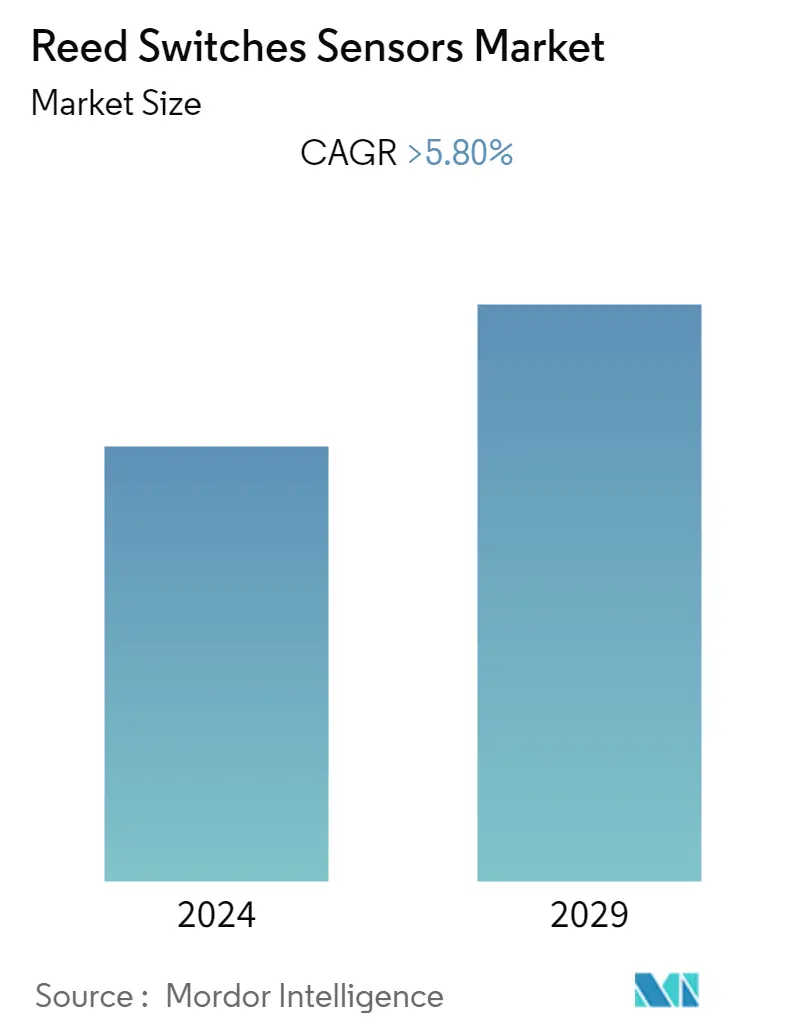Market Size of Reed Switches Sensors Industry

| Study Period | 2019 - 2029 |
| Base Year For Estimation | 2023 |
| Forecast Data Period | 2024 - 2029 |
| CAGR | 5.80 % |
| Fastest Growing Market | Asia Pacific |
| Largest Market | Asia Pacific |
Major Players
*Disclaimer: Major Players sorted in no particular order |
Reed Switches/Sensors Market Analysis
The automotive reed switches/sensors market is expected to register a CAGR of 5.8%during the forecast period(2020-2025).
- Technological advancements in the sensor and switch technology have resulted in advanced, miniature, and highly reliable reed switches, acting as a driver for the employment of these switches in the automotive industry.
- Changing consumer preferences for safer driving experience have also forced the manufacturers to seek better safety sensors, like pedal angle sensors, ABS, and EBS.
- Reliability and durability are challenges for reed switch users. Reed switches have several inherent disadvantages, including susceptibility to breakage issues during installationand its susceptibility to shock or vibration applications, lower durability, a limited life due to the mechanical nature of the switch, as well as issues due to the contact bounce. When leads on the reed switches are soldered into the circuit, they bend significantly, which can easily crack the glass enclosure of the switch, making the switch unusable. Therefore, reed switch manufacturerscarefully providespecific installation instructions, in order to limit this breakage.
Reed Switches/Sensors Industry Segmentation
The reed switch is an electrical switch operated by an applied magnetic field. It consists of a pair of contacts on ferrous metal reeds in an airtight glass envelope. The contacts are normally open, making no electrical contact. The switch is actuated (closed) by bringing a magnet near the switch. All areas of typical automotive systems incorporate low-profile, zero power consumption reed switch sensors to help them operate reliably and safely. Reed switch is used to support various automotive applications, such as speedometer, power window operation, infotainment, and in-vehicle navigation centers, side and rearview mirrors, cruise control and power steering, door lock actuation, etc. The aforementioned features of automotive reed switches/sensors have been considered in the scope of the market.
The automotive reed switches/sensors market has been segmented by application, vehicle type, and geography.
| Application Type | |
| Cruise Control | |
| Infotainment Systems | |
| Safety Systems | |
| Other Application Types |
| Vehicle Type | |
| Passenger Cars | |
| Commercial Vehicles |
| Geography | ||||||
| ||||||
| ||||||
| ||||||
|
Reed Switches Sensors Market Size Summary
The automotive reed switches and sensors market is poised for significant growth, driven by technological advancements that have led to the development of advanced, miniature, and highly reliable reed switches. These innovations are increasingly being adopted in the automotive industry to enhance safety features, such as pedal angle sensors, ABS, and EBS, in response to changing consumer preferences for safer driving experiences. Despite challenges related to reliability and durability, including susceptibility to breakage during installation and issues with shock or vibration, manufacturers are providing specific installation instructions to mitigate these problems. Reed sensors are particularly valued for their role in passive safety systems, such as early brake sensing, which alerts drivers to potential collisions.
The demand for automotive reed switches and sensors is further bolstered by the rising number of global accidents and the implementation of safety norms in various countries, which mandate the inclusion of safety features like anti-lock braking systems. The Asia-Pacific region, with India and China emerging as key manufacturing hubs, is expected to drive market growth due to its expanding automobile sector. The market is characterized by fragmentation, with numerous regional players, although major companies like Continental AG and Standex International Corp. hold significant market shares. Ongoing efforts to enhance the size, performance, and durability of reed switches are anticipated to accelerate market demand, as automobile manufacturers seek more reliable and cost-effective sensor solutions.
Reed Switches Sensors Market Size - Table of Contents
-
1. MARKET DYNAMICS
-
1.1 Market Drivers
-
1.2 Market Restraints
-
1.3 Industry Attractiveness - Porter's Five Forces Analysis
-
1.3.1 Threat of New Entrants
-
1.3.2 Bargaining Power of Buyers/Consumers
-
1.3.3 Bargaining Power of Suppliers
-
1.3.4 Threat of Substitute Products
-
1.3.5 Intensity of Competitive Rivalry
-
-
-
2. MARKET SEGMENTATION
-
2.1 Application Type
-
2.1.1 Cruise Control
-
2.1.2 Infotainment Systems
-
2.1.3 Safety Systems
-
2.1.4 Other Application Types
-
-
2.2 Vehicle Type
-
2.2.1 Passenger Cars
-
2.2.2 Commercial Vehicles
-
-
2.3 Geography
-
2.3.1 North America
-
2.3.1.1 United States
-
2.3.1.2 Canada
-
2.3.1.3 Rest of North America
-
-
2.3.2 Europe
-
2.3.2.1 Germany
-
2.3.2.2 United Kingdom
-
2.3.2.3 France
-
2.3.2.4 Rest of Europe
-
-
2.3.3 Asia-Pacific
-
2.3.3.1 China
-
2.3.3.2 Japan
-
2.3.3.3 India
-
2.3.3.4 Rest of Asia-Pacific
-
-
2.3.4 Rest of the World
-
2.3.4.1 Brazil
-
2.3.4.2 South Africa
-
2.3.4.3 Other Countries
-
-
-
Reed Switches Sensors Market Size FAQs
What is the current Reed Switches Sensors Market size?
The Reed Switches Sensors Market is projected to register a CAGR of greater than 5.80% during the forecast period (2024-2029)
Who are the key players in Reed Switches Sensors Market?
Aleph America Corporation, Continental AG, Standex International Corp. and TE Connectivity Ltd are the major companies operating in the Reed Switches Sensors Market.

